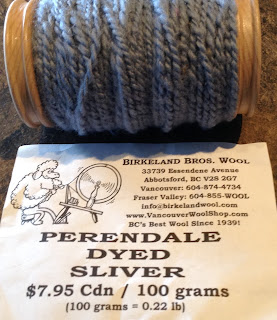As I thought about beading on Friday it became clear there weren't the right type of beads in the house. Since I am taking a class about beading at a bead shop on Saturday, August 13 I decided to focus on spinning instead.
The periwinkle dyed Perendale spun last Wednesday was quite an improvement over the poor honey fig coloured merino that was butchered during spinning the week before. On Thursday and Friday I went about seeing what I could find regarding spinning lessons. I was also investigating Sweet Georgia Yarns because that merino braid came from there and I want to do another braid of it justice.
Sweet Georgia Yarns have been on my radar for some time. Felicia Lo, the owner, began the company in 2005 in her kitchen. She has over 10 years later created a successful business in hand dying yarns and roving for knitters and spinners. Many LYS in the Greater Vancouver area carry her vibrant yarns and it is always those colours that attract me. So I poured over her website. (At the start I was obsessed with finding more of the honey fig roving, but that soon changed.)
Felicia teaches spinning. Apparently she once taught at Place des Arts in Coquitlam, BC where I learned, it appears she may have taught spinning at her retail shop in Vancouver and she is teaching several dyeing classes at Vogue Knitting Live in Minneapolis in November; I did not sign up for those classes, however, when I registered.
I was now like a sniffer dog on the scent to find out more about learning from this gifted dyer and spinner when I clicked on the classes she teaches to find she has a class on Craftsy. I immediately purchased it and spent most of Friday viewing all seven lessons in one sitting. It was all so motivating.
I picked up the second 50 grams of the periwinkle Perendale and spun it on Friday as well. Just following a few ideas I got from the class my spinning improved once more. Then I plied the two 50 grams bobbins together; it is still on the bobbin in the picture below. The yarn has been settling over the weekend; it will be placed in a hank and washed today. At the moment it is still quite rough to the touch so it may be used to make something like house slippers, but it will need to be reassessed after the wash to see if its current characteristics change.
Tomorrow there will be a trip to the Sweet Georgia Yarns retail shop where I hope to pick up at least another braid of that merino. I also learned to navajo or chain ply from Felicia's Craftsy class. I want to practice it in the next few days to help insure I can do it properly before I use it in earnest.
It was a creative Friday mainly filled with inspiration. That will carry me for some time with regard to spinning.
Speaking of inspiration take a look at this most recent pic of Miss M. She's heading out for her day on Monday! (I thought I would be preemptive and get a picture out of her before someone asked.) I love the fact her hair lightens so much in the summer sun. It reminds me of her dad's hair turning almost white during the summer months when he was her age.
The periwinkle dyed Perendale spun last Wednesday was quite an improvement over the poor honey fig coloured merino that was butchered during spinning the week before. On Thursday and Friday I went about seeing what I could find regarding spinning lessons. I was also investigating Sweet Georgia Yarns because that merino braid came from there and I want to do another braid of it justice.
 |
| Photo from the Sweet Georgia website |
Felicia teaches spinning. Apparently she once taught at Place des Arts in Coquitlam, BC where I learned, it appears she may have taught spinning at her retail shop in Vancouver and she is teaching several dyeing classes at Vogue Knitting Live in Minneapolis in November; I did not sign up for those classes, however, when I registered.
 |
| Felicia Lo from her website |
I picked up the second 50 grams of the periwinkle Perendale and spun it on Friday as well. Just following a few ideas I got from the class my spinning improved once more. Then I plied the two 50 grams bobbins together; it is still on the bobbin in the picture below. The yarn has been settling over the weekend; it will be placed in a hank and washed today. At the moment it is still quite rough to the touch so it may be used to make something like house slippers, but it will need to be reassessed after the wash to see if its current characteristics change.
Tomorrow there will be a trip to the Sweet Georgia Yarns retail shop where I hope to pick up at least another braid of that merino. I also learned to navajo or chain ply from Felicia's Craftsy class. I want to practice it in the next few days to help insure I can do it properly before I use it in earnest.
It was a creative Friday mainly filled with inspiration. That will carry me for some time with regard to spinning.
Speaking of inspiration take a look at this most recent pic of Miss M. She's heading out for her day on Monday! (I thought I would be preemptive and get a picture out of her before someone asked.) I love the fact her hair lightens so much in the summer sun. It reminds me of her dad's hair turning almost white during the summer months when he was her age.


Comments
Post a Comment